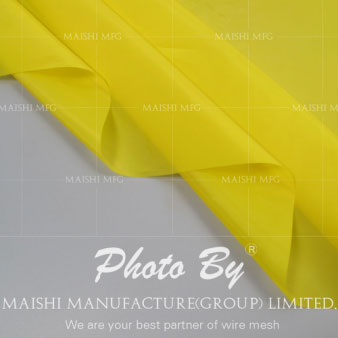You will have to abandon your desire to do simple spot color jobs on mesh counts like 110 or lower and adopt the use of newer mesh counts.(check full range of specifications from MAISHI WIRE MESH MANUFACTURE GROUP.)
In order to use the newest monofilament polyester screen fabrics to your advantage, you will need to understand a simple characteristic of screen printing mesh. We will be focusing on how a fabric's thread diameter affects the mesh geometry. That is to say, we will look at how the thread diameter of the mesh will affect the overall ink flow or increase the mesh opening for any given mesh count. We know not everyone is expert in technical, so we will try not to get over technical here but there is a certain amount of tech talk needed in order to continue.

(If you're not clear about the specifications, please read this artical: the meaning of mesh specification parameter.) Keeping that in mind, let's take a look at two mesh counts for the purposes of illustrating the concept. If we have a mesh count of 110 which is made with a standard 80 micrometer thread, we know the mesh opening is about 40% with a mesh tension of 33 N/cm, (Newtons per centimeter). 43% is the number to focus on here because this represents the percentage of open area of the mesh at a specific tension. The higher this number is, the better the ink flow will be through the mesh. Now we also know that printing with 110 mesh has its own inherent qualities like loss of detail or "saw tooth-ing". And it also provides for a rougher ink surface when printing an under base. Now what if we could use a higher mesh count that had a similar or better mesh opening ratio?Let's now consider a mesh count of 155, made with a 48 micron diameter thread and stretched at 30 N/cm. This screen will have a mesh opening ratio of around 49%. If we look at the two percentages, you will see the 110 has a 40% mesh opening and the 155 has a 49% mesh opening. So, even though the 155 mesh is a higher thread count in comparison to the 110, it still has more open area. This allows for greater ink saturation in the print area, improving the opacity and the color intensity of the print. Although this mesh may have a little bit lower theoretical ink volume, it will have better ink flow characteristics and allow a reduction in squeegee pressure too. This will produce a thinner, more even and smooth ink deposit which creates a softer hand or feel to the print. Mesh like this is sometimes referred to as "thin mesh".
This type of mesh can have great advantages for many reasons. Reducing squeegee pressure can increase image detail. It can also reduce stencil drag which in turn improves registration. Also, it is important to note that ink opacity or coverage is affected by factors other than ink volume such as the substrate and even the ink quality itself. In standard conditions, a smooth, even deposit of a lesser amount of ink will produce a more colorful and opaque print than applying thicker layers of ink.
Using a mesh like the aforementioned 155/48 or maybe a 135/40 for a white under base is an excellent usage of this type of mesh. The under base will be able to render details needed for the design and it will produce a better surface than would be produced by the 110/80 mesh. As you may already know, a smoother, thinner, more consistent under base is ideal for halftones. A thin mesh could also help reduce clogging with water based inks and back flooding.
Some advantages of "thin mesh":Better ink flow with less effort
Great coverage with minimal ink volume
Creates a smoother, more consistent surface
Requires less squeegee pressure
Improves print quality or detail
Higher mesh counts generally cost more.
Easier to achieve stencil detail
Elimination of fabric interference in halftones
Creates a softer hand print
Welcome to contact MAISHI WIRE MESH MANUFACTURE GROUP. for more details.
PREVIOUS: Some important notes about higher mesh counts and yellow mesh
NEXT:Some knowledge you need to pay attention to when inspect welded wire mesh














